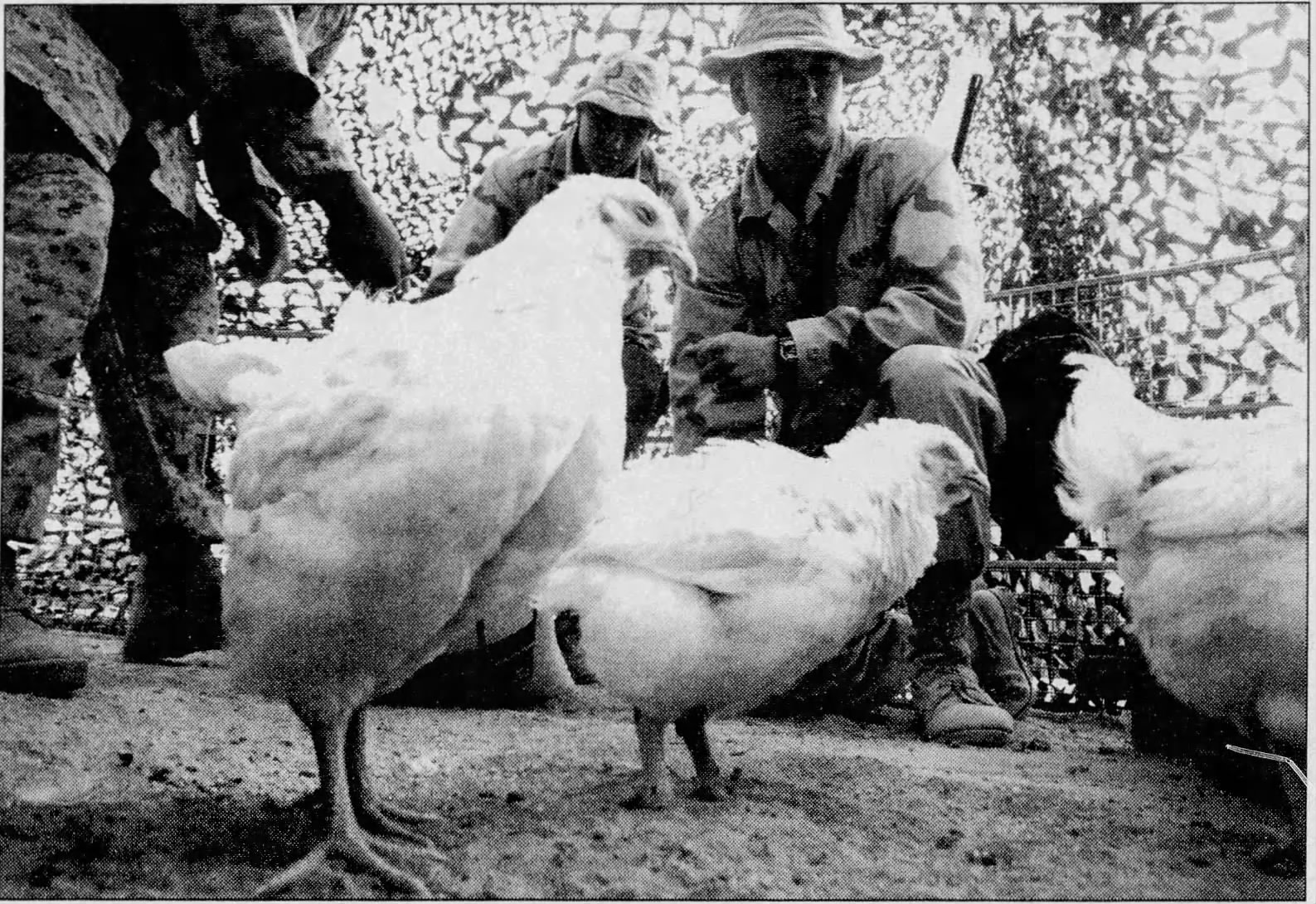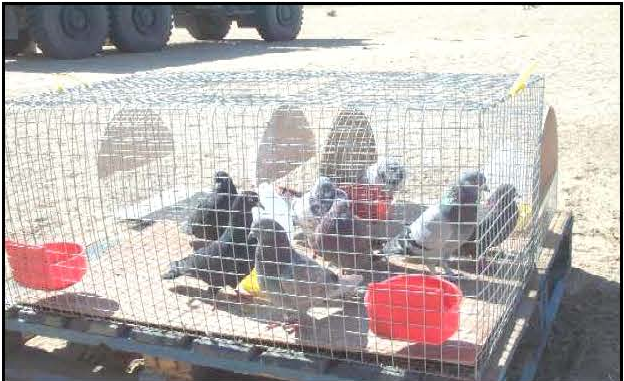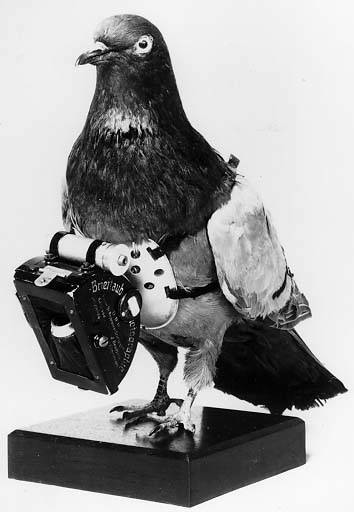
When people think of military pigeons, they usually associate them with a bygone era. It may come as a shock to many to learn that pigeons were actually used by the United States military in the 21st Century. This week, we take a look at an interesting chapter of the Iraq War involving pigeons and chemical detection.
Throughout February 2003, the 1st Marine Division was stationed at Camp Matilda in Kuwait, waiting for the command to march toward Baghdad. As they prepared for the invasion, military planners feared a chemical attack might be launched by Saddam Hussein’s forces. Marines were given smallpox and anthrax vaccines and outfitted with gas masks, rubber boots and gloves, and charcoal-lined camouflage suits. Yet the Division’s chemical detection systems often gave false positive readings when in contact with petroleum-based vapors—an element that could not be avoided in oil-rich Iraq. A false reading would require troops to put on their protective gear, impacting their performance and wasting precious time.
To remedy this issue, Chief Warrant Officer Stacy Jeambert advocated for the use of a Sentinel Species, an organism that could be used to detect early indications of chemical agents in the air—a canary in a coal mine is a classic example. If the bird drops dead, it’s a sign that folks need to immediately evacuate the area. The Marines even had a history of using birds as Sentinel Species. During the Gulf War, a “sizeable number of parakeets” were provided to the 2nd Marine Division for chemical detection. Chickens were also used for this purpose—Jeambert had kept five of them nearby when he served in that conflict.

Drawing on his past experiences, Jeambert arranged for the Division to purchase 200 chickens from a young Kuwaiti entrepreneur. A chicken coop was built for the birds and plans were made to “fatten them up” before using them for detection work. Afterwards, the chickens were to be caged and placed in a truck near the front of base, where their constant clucking would indicate that all was well.

Within days, however, problems quickly surfaced. Several of the chickens wandered off into the desert, while others possibly were eaten. One week in, most had died from the arid desert climate—it was claimed that as laying hens, they simply were not suited to the desert’s cold nights and sandstorms.

The Division turned next to pigeons, a much hardier bird. On March 14th, the Division procured 175 from a local bird dealer for about $55 a piece The birds were handed out to regimental combat teams and battalions, placed under the charge of lance corporals. Officials took deliberate efforts to ensure the pigeons would thrive. The commanding officer of the 3rd Battalion, for instance, instructed his Marines to give the birds bottled water and find “pigeon-qualified personnel” to care for them.

On March 19th, the US military commenced its invasion of Iraq. The 1st Division’s Marines loaded their pigeons into the back of Humvees and armored vehicles before speeding out of Kuwait. During their 28-day trek toward Baghdad, the Marines kept a close eye on the birds for signs of a chemical attack. Unlike the chickens, the pigeons quickly adapted to desert life—few, if any, died. Thankfully, by mid-April, the troops had taken Baghdad without a single instance of chemical weapons being deployed. At this point, the Marines freed their pigeons from their military obligations, turning them loose into the wild.

During their time together, many of the Marines bonded with the pigeons, even giving them colorful nicknames such as Boudreaux, Outlaw, Trigger, Sarsaparilla, Jackball, and Doc. One pigeon, Pidgeodo, got to visit Saddam’s palace in Tikrit before being relieved of duty. Another bird, Petey, established a tight rapport with his unit. In their off time, the Marines fed him crackers and cooed to him. They also looked after his morale. When they set up camp in Baghdad, some Iraqi pigeons started taunting Petey with mating calls. To boost his spirits, his comrades placed a pin-up photo in his cage. In recognition of his service, his caretakers opted to take him back to Kuwait in person.

In spite of this affection, the Marines also were very much aware that, at the end of the day, their pigeons were just “another item to lug across the desert.” “It was a pet and cargo,” a Lance Corporal remarked. Moreover, not everyone was a fan of the birds—one Gunnery Sergeant grumbled that his unit’s pigeon “just sits there. And it drinks our water too.”

A 2006 history of the 1st Division’s time in Iraq provides an apt summary of the benefits the pigeons brought to the Corps:
The Sentinel Species concept was validated, and instilled additional confidence in the Marines’ ability to operate in a contaminated environment. The skepticism and humor with which this employment was met also provided valuable comic relief at a time of heightened tension. A sense of humor was a critical aspect of courage as the Marines prepared to attack into the unknown.
Sources:
- Clay, Diane, “U.S. Military Enlists Animal Aides Dogs, Sea Lions, Even Chickens Used in Iraqi Operations,” The Oklahoman, Mar. 25, 2003, available at https://www.oklahoman.com/story/news/2003/03/25/us-military-enlists-animal-aidesbrdogs-sea-lions-even-chickens-used-in-iraqi-operations/62051684007/
- Gerlin, Andrea, “Chickens Out, Pigeons In,” The Post-Star, Mar. 15, 2003, at 3.
- Groen, Michael, With the 1st Marine Division in Iraq, 2003: No Greater Friend, No Worse Enemy, at 112-113 (2006).
- “If the Parakeets Keel Over, Put on Your Mask,” Longview Daily News, Feb. 23, 1991, at 16.
- “Marines Have Pigeons Waiting in Wings to Detect Chemical Attack,” St. Louis Post-Dispatch, Mar. 16, 2003, at 7.
- Osnos, Evan, “With the 1st Marine Expeditionary Force,” The Chicago Tribune, Mar. 30, 2003, at 1-6.
- Peterson, Patrick, “Duty Done, Pigeon Will Fly the Coop,” The Sun Herald, Apr. 17, 2003, at 4.
- “Pigeons Are Marines’ Sitting Ducks,” Pocono Record, Mar. 14, 2003, available at https://www.poconorecord.com/story/news/2003/03/15/pigeons-are-marines-sitting-ducks/50978461007/
- Robinson, Simon, “The Chicken Defense, Time Magazine, Feb. 18, 2003, available at https://content.time.com/time/subscriber/article/0,33009,423690,00.html

6 responses to “Pigeons in the Iraq War”
[…] Журнал Time , февраль , 1940, можно купить в https://content.time.com/time/subscriber/article/0,2017,2042,.html Святая Ольга Киевская: пионер голубиного дела […]
LikeLike
[…] Pigeons in the Iraq War – Pigeons of War – Very interesting find from the gruqg […]
LikeLike
I was with 1st Marine Division in Iraq 2003. Thank you so much for the story & pictures. My vehicle had a small cage strapped to the hood with two pigeons inside. They actually brought comfort to us and a piece of mind. 19 years later, every time I see a pigeon on the street, I think of the pigeons in Iraq. This was a great story & brought back some good memories. With your permission & giving the writer full credit. Can I use this story on my TikTok page. I create military content. (TikTok @sgt.sandog)
LikeLiked by 1 person
Thank you so much reading my post—I’m glad you liked it! Sure, you have my permission to use this blog in your TikTok; just be sure to credit it to Justin Craig (not sure my name is on this site). Look forward to seeing it!
LikeLike
Thank you so much. I will definitely put something together on my TikTok page. I’ll give you full credit. I’ll give you a heads up when I post it.
LikeLiked by 1 person
[…] weeks ago, we wrote about how the 1st Marine Division used pigeons for chemical detection in the first months of the Iraq War. A rare instance of pigeons being used in modern warfare, the article has become the most […]
LikeLike